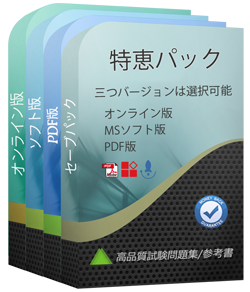購入後、どれくらいGRE-Verbal試験参考書を入手できますか?
あなたは5-10分以内にAdmission Test GRE-Verbal試験参考書を付くメールを受信します。そして即時ダウンロードして勉強します。購入後にGRE-Verbal試験参考書を入手しないなら、すぐにメールでお問い合わせください。
割引はありますか?
我々社は顧客にいくつかの割引を提供します。 特恵には制限はありません。 弊社のサイトで定期的にチェックしてクーポンを入手することができます。
あなたはGRE-Verbal試験参考書の更新をどのぐらいでリリースしていますか?
すべての試験参考書は常に更新されますが、固定日付には更新されません。弊社の専門チームは、試験のアップデートに十分の注意を払い、彼らは常にそれに応じてGRE-Verbal試験内容をアップグレードします。
あなたのテストエンジンはどのように実行しますか?
あなたのPCにダウンロードしてインストールすると、Admission Test GRE-Verbalテスト問題を練習し、'練習試験'と '仮想試験'2つの異なるオプションを使用してあなたの質問と回答を確認することができます。
仮想試験 - 時間制限付きに試験問題で自分自身をテストします。
練習試験 - 試験問題を1つ1つレビューし、正解をビューします。
Tech4Examはどんな試験参考書を提供していますか?
テストエンジン:GRE-Verbal試験試験エンジンは、あなた自身のデバイスにダウンロードして運行できます。インタラクティブでシミュレートされた環境でテストを行います。
PDF(テストエンジンのコピー):内容はテストエンジンと同じで、印刷をサポートしています。
更新されたGRE-Verbal試験参考書を得ることができ、取得方法?
はい、購入後に1年間の無料アップデートを享受できます。更新があれば、私たちのシステムは更新されたGRE-Verbal試験参考書をあなたのメールボックスに自動的に送ります。
返金するポリシーはありますか? 失敗した場合、どうすれば返金できますか?
はい。弊社はあなたが我々の練習問題を使用して試験に合格しないと全額返金を保証します。返金プロセスは非常に簡単です:購入日から60日以内に不合格成績書を弊社に送っていいです。弊社は成績書を確認した後で、返金を行います。お金は7日以内に支払い口座に戻ります。
GRE-Verbalテストエンジンはどのシステムに適用しますか?
オンラインテストエンジンは、WEBブラウザをベースとしたソフトウェアなので、Windows / Mac / Android / iOSなどをサポートできます。どんな電設備でも使用でき、自己ペースで練習できます。オンラインテストエンジンはオフラインの練習をサポートしていますが、前提条件は初めてインターネットで実行することです。
ソフトテストエンジンは、Java環境で運行するWindowsシステムに適用して、複数のコンピュータにインストールすることができます。
PDF版は、Adobe ReaderやFoxit Reader、Google Docsなどの読書ツールに読むことができます。
Admission Test Section One : Verbal 認定 GRE-Verbal 試験問題:
1. FAWN:
A) win over
B) insult
C) dominate
D) grow stronger
E) boast
2. ROBUST : VIGOR ::
A) nervous : worry
B) starving : appetite
C) farsighted : glasses
D) sanguine : hope
E) massive : strength
3. The heart of the restorationist critique of environmental preservationism is the claim that it rests on an
unhealthy dualism that conceives nature and humankind as radically distinct and opposed to each other.
The crucial question about the restorationist outlook has to do with the degree to which the restorationist
program is itself faithful to its first principle- that nature and humanity are fundamentally united rather than
separate. Rejecting the old domination model, which sees humans as over nature, restoration theory
champions a model of community participation. Yet some of the descriptions of what restorationists are
actually up to-for example, Turner's description of humans as "the lords of creation," or Jordan's
statement that "the fate and well being of the biosphere depend ultimately on us and our relationship with
it"-do not cohere well with the community-participation model. Another holistic model-namely, that of
nature as an organism-might be more serviceable to the restorationists. As with the community model,
the "organic" model pictures nature as a system of interconnected parts. A fundamental difference,
however, is that in an organism the parts are wholly subservient to the life of the organism.
In asserting that the organic model"might be more serviceable to the restorationists" (lines 28-30), the
author implies that
A) the organic model is more consistent than the community participation model with the principle of
restoration
B) the descriptions by Turner and Jordan of the restorationists' program conform more closely to the
organic model than to the community participation model
C) the organic model is more consistent with the restorationists' agenda than with the preservationists'
program
D) holistic models are more useful than the dualist model to the restorationists
E) the organic model, unlike the community participation model, represents nature as a system of
interconnected parts
4. One of the most intriguing stories of the Russian Revolution concerns the identity of Anastasia, the
youngest daughter of Czar Nicholas II. During his reign over Russia, the Czar had planned to revoke
many of the harsh laws established by previous czars. Some workers and peasants, however, clamored
for more rapid social reform. In 1918 a group of these people, known as Bolsheviks, overthrew the
government. On July 17 or 18, they murdered the Czar and what was thought to be his entire family.
Although witnesses vouched that all the members of the Czar's family had been executed, there were
rumors suggesting that Anastasia had survived. Over the years, a number of women claimed to be Grand
Duchess AnastasiA. Perhaps the best -known claimant was Anastasia Tschaikovsky, who was also
known as Anna Anderson. In 1920, eighteen months after the Czar's execution, this terrified young
woman was rescued from drowning in a Berlin river. She spent two years in a hospital, where she
attempted to reclaim her health and shattered mind. The doctors and nurses thought that she resembled
Anastasia and questioned heer about her background. She disclaimed any connection with the Czar's
family. Eight years later, though, she claimed that she was AnastasiA. She said that she had been
rescued by two Russian soldiers after the Czar and the rest of her family had been killed. Two brothers
named Tschaikovsky had carried her into RomaniA. She had married one of the brothers, who had taken
her to Berlin and left her there, penniless and without a vocation. Unable to invoke the aid of her mother's
family in Germany, she had tried to drown herself. During the next few years, scores of the Czar's
relatives, exservants, and acquaintances interviewed her. Many of these people said that her looks and
mannerisms were evocative of the Anastasia that they had known. Her grandmother and other relatives
denied that she was the real Anastasia, however. Tried of being accused of fraud, Anastasia immigrated
to the United States in 1928 and took the name Anna Anderson. She still wished to prove that she was
Anastasia, though, and returned to Germany in 1933 to bring suit against her mother's family. There she
declaimed to the court, asserting that she was indeed Anastasia and deserved her inheritance. In 1957,
the court decided that it could neither confirm nor deny Anastasia's identity. Although we will probably
never know whether this woman was the Grand Duchess Anastasia, her search to establish her identity
has been the subject of numerous books, plays, and movies.
She was unable to ___the aid of her relative.
A) identify
B) call upon
C) locate
D) know
E) speak about
5. SYNERGIZE:
A) catalyze
B) atrophy
C) lapse
D) languish
E) sabotage
質問と回答:
| 質問 # 1 正解: C | 質問 # 2 正解: D | 質問 # 3 正解: B | 質問 # 4 正解: B | 質問 # 5 正解: E |


 弊社は製品に自信を持っており、面倒な製品を提供していません。
弊社は製品に自信を持っており、面倒な製品を提供していません。



 -Toyoshima
-Toyoshima

